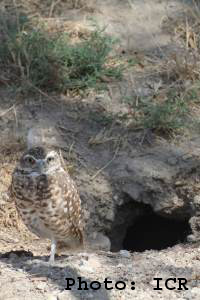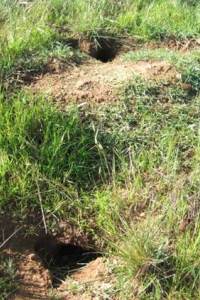
Deutschman Lab Projects
The Western Burrowing Owl (Athene cunicularia hypugaea) is a widespread species that shows tolerance towards human disturbances, but observations of population decline across its range have been published in the past 15 years, including local populations in southern California. The driving factors behind this decline are reduced habitat area from urban development, changes in grassland species composition, and changes in the distribution and abundance of the fossorial mammal, California Ground Squirrel (Otospermophilus beecheyi), that produces burrows for Burrowing Owls. Ground Squirrels are the key to establishing self-sustaining burrowing owl populations in southern California, but squirrels were historically- and still are currently- widely perceived as pests that damage crops and need to be controlled. In addition, a proportion of Burrowing Owl individuals appear to make maladaptive habitat selection choices, choosing to breed in anthropogenically altered habitats such as airports, agricultural fields, and roadsides. A better understanding of these habitat selection choices could contribute to the understanding of how populations decline. Better understanding could lead in turn to better chances of successful habitat restoration and more efficient allocation of management resources.
This research project is designed as a three step process to identify key drivers of Burrowing Owl persistence, analyze the degree of uncertainty about each key driver, and conduct experiments to resolve uncertainty. We utilize two experimental approaches: simulations with a model system, and replicated treatments in a field setting. A Bayesian-based analysis of published life history data will measure the current degree of uncertainty about the available information. Life history variable estimates from the Bayesian analysis will parameterize an individual-based model (IBM) designed to produce and evaluate predictions of population outcomes based on the current understanding of owl habitat selection rules. The project also includes a field-based experiment to examine the role of Ground Squirrels and vegetation structure, and the feasibility of habitat restoration for owls through vegetation management and translocation of squirrels to sites managed for Burrowing Owls. The field project is a collaborative effort between the Institute for Ecological Modeling and Management at San Diego State University and the San Diego Zoo's Institute for Conservation Research.
The broader significance of this research will be in exploring how environmental habitat cues interact with behavioral habitat selection rules in order to drive population dynamics in highly altered landscapes. The analytical and modeling tools described above allow us to link environmental factors and individual behavior with population-level outcomes.
Research Tasks
1. Use model simulations to measure the degree of uncertainty about the available life history data
2. Evaluate habitat restoration techniques for Burrowing Owls
Lead Biologist: Sarah McCullough
Monitoring and Adaptive Management of Burrowing Owl on Conserved Lands In Southern San Diego County

